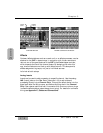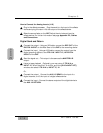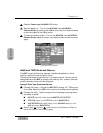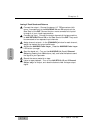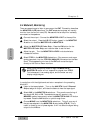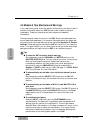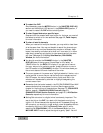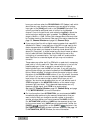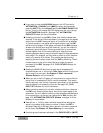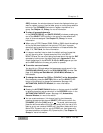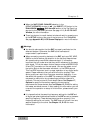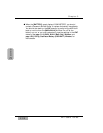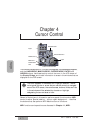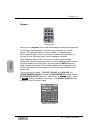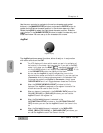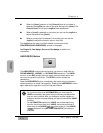
Chapter 3
DA7 Users’ Guide
3
-
20
3
Quick Start
● If you want to view the AUX SEND status on the LED field while
AUTOMATION is [ENABLE] and [MMC] is active, simultaneously
press the SHIFT key of the Keypad and the AUTOMATION/AUX LED
button. This will only change the LED display, and will not interrupt
the AUTOMATION operation. See page 14-5, AUTOMATION,
EXECUTE Window, for more information.
● Dithering the output of the DA7 to fewer than 24 bits is sometimes
required. If the correct Dither adjustment is not applied to the signals
output from the DA7, the sound quality of the audio will be affected.
In normal operation, the digital audio signals output from the DA7
are 24 bit word lengths. If the device connected to the DA7 operates
at fewer than 24 bits (such as a DAT machine), you will be unable to
completely record the signal. Dithering permits you to connect two
devices together that do not have matching bit rates (but have
matching sample rates) by using a complex algorithm that reduces the
word length. For example, you may wish to record to a DAT machine
which only records 16 bit words. This problem can be solved by
adjusting the word length output from the DA7 by Dithering. The bit
number output by the mixer should be set to match the device
connected to the DA7. See page 12-14, D-I/O, DITHER Window, for
more details.
● Pressing the FLIP LED buttons is an easy way to access specific
channels that are not in the current Fader Layer without flipping the
entire mixer to a new layer. See Chapter 6, Fader Layers and
Channel Strips for more information.
● When you are in the D-I/O page, you may encounter a source field or
button that is "crosshatched" and/or cannot be selected. This means
that the source or slot is either improperly connected, or the attached
external device is not presently turned on. See page 12-2, D-I/O,
INPUT SET Window, for more information.
● When producing material for use with a video production, reference
the DA7 to an incoming video signal. Do this during all stages of the
production. You will need to know the video reference characteristics
for the production, so that you can reference the DA7 correctly. See
page 14-5, AUTOMATION, EXECUTE Window, and page 10 of the
Glossary for more details.
● Data with an -∞ (infinity) fader level and flat equalizer settings are
stored to the scene library memory number 01 when the DA7 is
delivered. Data with 0 dB fader level is stored in the other memories
of the library. See Chapter 15, Scene Memory, for more details.
● Once the groups have been activated in the [FADER GRP] or [MUTE



